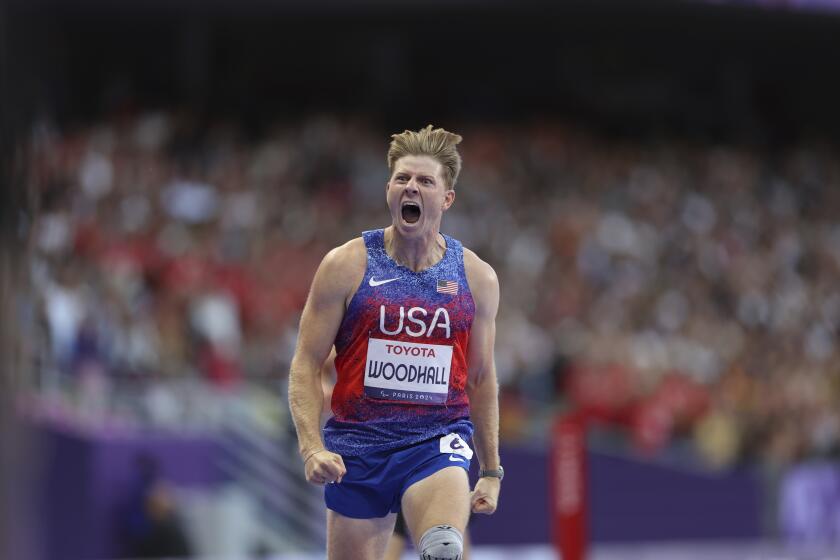Manley Makes Her Most Difficult Climb : Cyclist’s Olympic Goal Intact Despite Battle With Multiple Sclerosis
The unexplained weakness didn’t send her rushing to a doctor. Neither did the blurred vision. As an elite cyclist riding 350 to 400 mountainous miles a week, national team member Maureen (Mo) Manley regarded a malfunctioning body as part of the job.
Explaining her indifference to her symptoms, she said, “You have things go weird all the time, but you push through them and hopefully they go away.”
This time, they didn’t.
On Sept. 23--about a month after first experiencing fatigue and vision problems--Manley, 26, underwent a magnetic resonance imaging test and was found to have multiple sclerosis, a debilitating neuromuscular disease with no known cause or cure. For a fitness fanatic such as Manley--a coach calls her “a demon in the hills”--the news was “shattering,” she said. “It threw me and everybody else for a loop.”
Manley’s initial thought: “Great, I’ll be in a wheelchair by next year and then die a slow death.”
That first glimpse of her own mortality was Manley’s lowest moment. But when she began to learn about the disease, her anxiety diminished. Like a lot of people, Manley had misconceptions about MS, which afflicts 250,000 Americans. While MS can cause periods of fatigue and blurred vision, “It isn’t a death sentence,” said Kathy Bycel, services director of the Santa Barbara chapter of the National Multiple Sclerosis Society.
Manley was relieved. “Most people (with MS) lead normal lives,” said Manley, who grew up in Thousand Oaks and now lives in Boulder, Colo.
Cycling thousands of miles a year, however, is not normal, and MS, while not the killer Manley imagined, usually puts an end to an athlete’s career: The National MS Society knows of no world-class athletes who have remained competitive at the highest levels of their sport after contracting the disease.
Although Manley’s chances of regaining peak form seem slim--especially in road racing, a sport in which fitness is essential and fractions of a second can separate great riders from good ones--she remains optimistic.
“In my heart, I know I’m definitely going to live a healthy, great life,” she said. “Whether that includes racing my bicycle, I don’t know. But I’m not going to stop trying.”
Last December, Manley underwent her first steroid treatment, using a corticosteroid that is allowed by the U.S. Olympic Committee because of her medical condition.
Now, the MS is in remission. She is feeling less fatigued and reports that her vision is back to normal. To train for the Olympic team, Manley, her coaches and her doctors have planned a campaign that builds gradually instead of flowing through a series of peaks and valleys. The idea is to avoid extended periods of stress and exhaustion, conditions that are thought to bring about an outbreak of the disease.
But the problem in trying to beat MS is that nobody can predict which course it will take--whether a person will have a mild case or need a wheelchair. Medical experts cannot tell Manley when to expect her next attack or even if she will have one. “Some people have a benign case and only have that first exacerbation,” said Bycel, a psychotherapist. “The first five years will tell the tale.”
But for Manley, the cyclist, this is the crucial year. If she can rebound from her first attack and avoid another, “her performance might not be affected in ‘92,” said Dr. James Niven, national team doctor at last summer’s Pan American Games.
But Henny Top, U.S. women’s cycling coach, isn’t sure that cycling is the best medicine for Manley, the only U.S. woman to compete in two road-racing events in the 1991 World Cycling Championships in Germany.
Last October, when Manley called Top with the news that she had MS, Top did research on the disease. She learned that MS patients are instructed to stay out of the sun and get plenty of rest to avoid another outbreak, which can lead to permanent weakness. Top also found out that stress might ignite an episode, and she was aware that Manley was always stressed-out before a race.
“I was afraid she’d push it,” Top said. “I was afraid of the damage that could happen.”
Top also worried about liability. “It’s my responsibility if something happens,” Top said. “People could say to me: ‘You knew she had MS. Why did you (let her race)?’ ”
Top had good reason to worry. Last September, during Manley’s first outbreak and before the disease was diagnosed, Manley had an MS-related accident in the women’s Tour de France. During the first stage, Manley, experiencing blurred vision, gamely tried to chase the leaders over a narrow mountain road, but she couldn’t follow the course, took the wrong turn and “crashed pretty good.”
Manley sustained only bruises, but both she and Top knew that the accident could have been far worse. “I could have gone off the mountain and taken someone with me,” Manley said, shuddering at the thought of leading a pack of riders over a cliff.
After learning about MS, Top tried to talk Manley out of a comeback, asking her, “Is cycling or your life more important?” But Manley persuaded Top to allow her to control her own destiny.
So Top told Manley, “I will support you,” enabling Manley to join other national team members at a training camp in April in Texas. At that time, Top said, “We’ll see if she’s ready to go to Europe” for races this spring. “As of now, she’s on the list.”
MS has made Manley re-examine her priorities. She concluded that her life was more important than cycling. “If this (MS) didn’t happen,” she said, “right now I’d be pounding myself into the ground thinking ‘Olympics, Olympics.’ But now I’m thinking about my health, my happiness. If cycling proves too taxing on me, I’ll quit.”
To keep her stress levels down, Manley spends hours each day practicing relaxation techniques, and she is relying on her newfound mellow attitude to break the old behavior patterns.
Manley’s go-for-broke racing style will have to be tempered. “She’s really driven,” says Scott Warren, coach of T.G.I. Friday’s, Manley’s corporate team. “But one of her problems is that she’s always been over-motivated and overtrained. Maybe this disease is really a blessing in disguise.”
Manley, too, is trying to look on the bright side. “I’m telling myself I wasn’t hit by a Mack truck,” she said.
She credits the disease with bringing her closer to her boyfriend, Brad Barnard, a 26-year-old publicist for her corporate team. Before the diagnosis, he was living in Seattle and they didn’t tell anybody about their relationship. Now they’re living together in Boulder and don’t hide it.
Not keeping secrets is part of Manley’s stress-reduction strategy. At first, she wasn’t going to go public with her disease. She even initially told Top that she was suffering from an optic nerve problem, but she found that “lying totally was stressing me out.”
“I knew my having MS would eventually get out, and I didn’t want rumors flying,” she said. “And I also wanted to raise awareness of the disease and help people with it know that no matter what your limitations, you still have your life and love and passions.”
Manley’s health will determine her future. “If I can’t compete at the elite level,” she said, “I probably won’t race anymore, but I’ll always be a cyclist.”
More to Read
Go beyond the scoreboard
Get the latest on L.A.'s teams in the daily Sports Report newsletter.
You may occasionally receive promotional content from the Los Angeles Times.







